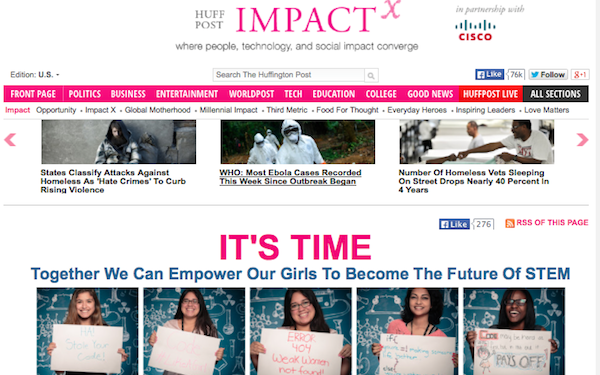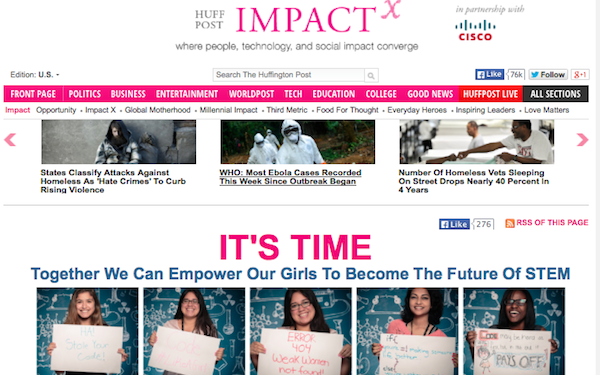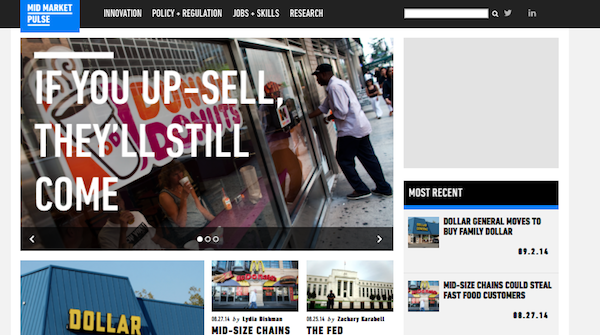
Publishers are betting big on so-called native ads, but scaling it is among the chief challenges getting it to catch on with advertisers. By a commonly accepted definition, native ads are tailored and unique to the host publisher, which limits their ability to reach the audience needed to justify the expense.
Here are three ways publishers are trying to solve for this conundrum:
Take advantage of editorial
The Huffington Post launched its native ad sales effort four years ago. It discovered early on that brands needed more content than they were willing to pay for. In the meantime, the HuffPost’s editorial team was churning out 1,600 posts a day. “It’s challenging and expensive for a brand to do this every single day,” said Lauri Baker, head of branded content for the HuffPost. “They needed scale, and always-on relevancy.” So the HuffPost created ad-sponsored sections that would pull in independently created but relevant editorial content and run it alongside the advertiser’s own posts that are labeled as such.
HuffPost has created sections like Love Matters for Johnson & Johnson and Generation Change for NRG Energy. A program for Chipotle, Food for Thought, got 18 million pageviews and 5 million social actions over the seven-month duration but consisted of about 90 percent HuffPost editorial content, Baker estimated. (Now that the program is over, the section remains live, but Chipotle content and references have been removed, she said.)
Another channel, Cisco’s Impact X, gets 1.5 million hits a month and promotes content Cisco wants to be associated with. “As a marketing person, you need to open the doors, be inclusive,” said Mary Anne Petrillo, senior manager, digital strategy for Cisco Corporate Social Responsibility. “If it was just our voice talking, nobody would be learning from our experience. You want to have more voices, because that’s how you become more relevant.”
Mine the data
There are bigger sites out there, but Slate has managed to provide relatively big reach for advertisers’ native ads. Part of the way it does this is through metrics that monitor elements like headlines, placement design, creative rotation and targeting. Slate serves the ads through the third-party Polar platform, which enables it to track and make changes to ad programs, said Lindsay Nelson, vp of integrated programs, who runs Slate’s in-house creative unit.
“It allows us to to test multiple forms of creative so you have this ability in real time to try three different headlines and see which works best,” she said. “We’re looking at stuff on the hour and making real-time decisions.”
Using this approach, Slate served more than 100 million ad impressions in August. Beyond getting impressions, Slate also puts an emphasis on creating content for native ads and branded-content sites like Mid-Market Pulse for GE Capital that resonate with readers: 35 percent of its native ads are shared on social networks, said the publisher.
Use your real estate
Forbes was an early adopter of what’s now called native, first letting advertisers blog in the editorial stream in 2010. The program evolved into what’s now called BrandVoice. The publisher is no less challenged than any other in trying to get enough scale for advertisers, though. That’s why this summer it began promoting clients’ BrandVoice pages with widgets that run in the left-hand rail of article pages. Those widgets are synched to run when the advertiser’s BrandVoice content is getting its home-page promotional turn, as Oracle’s was at the time this Jennifer Lawrence article was opened.
“One of the benefits of being a BrandVoice partner is, you have a designated time that you’re going to be on the homepage, and you have this native ad that’s on the site,” Forbes chief revenue officer Mark Howard said. “That’s been great for additional promotion but also brand exposure.”
More in Media

Publishers are hunting for AI prompt data — now they’re starting to get it from third-party companies
Publishers are finally gaining some visibility into AI search, as new prompt data tools crack open a black box.

Digiday+ Research: Publishers’ growing focus on video doesn’t translate to social platforms
Major publishers have made recent investments in vertical video, but that shift is not carrying over to social media platforms.

Technology x humanity: A conversation with Dayforce’s Amy Capellanti-Wolf
Capellanti-Wolf shared insight on everything from navigating AI adoption and combating burnout to rethinking talent strategies.








